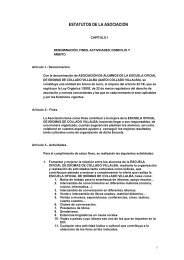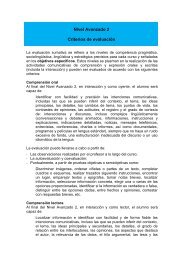Maquetación 1 - Escuela Oficial de Idiomas
Maquetación 1 - Escuela Oficial de Idiomas
Maquetación 1 - Escuela Oficial de Idiomas
Create successful ePaper yourself
Turn your PDF publications into a flip-book with our unique Google optimized e-Paper software.
26<br />
COSAS QUE NOS INTERESAN �<br />
WORKING WITH<br />
AUTISTIC CHILDREN<br />
Maria Jose Martín Herranz. Inglés Avanzado 2<br />
How would you feel if one of your children would never<br />
call you“mummy”or“daddy”, if he would<br />
never smile to you or even if he would never<br />
want to play with you? Unfortunately, these<br />
are some situations that any family with an<br />
autistic child have to face up to.<br />
In or<strong>de</strong>r to help these children there are<br />
fantastic and well-prepared professionals in<br />
Spain who attend them (both children and<br />
family) at state schools and associations. This<br />
article aims to <strong>de</strong>scribe in a very simple way<br />
how one of these professionals, the speechtherapist,<br />
works with one of the most<br />
interesting and unknown disor<strong>de</strong>rs in the<br />
world: the autistic disor<strong>de</strong>r.<br />
First of all, teachers always start consi<strong>de</strong>ring their<br />
pupils’ possibilities, even the autistic ones. In these<br />
cases, however, we must know perfectly well which<br />
their biggest difficulties are. As a general rule, these are<br />
the following:<br />
1. ORDER AND ROUTINES. It is necessary for them to<br />
know what they are going to do in every single<br />
moment, so if there are some changes we have to tell<br />
them in advance. When autistic children do not know<br />
what they are going to do, they feel insecure, anxious<br />
and extremely nervous. As a consequence they can<br />
start fluttering with their hands, repeating a sentence<br />
or they may even hurt themselves.<br />
This kind of behaviour can last for hours. For this<br />
reason, the teachers elaborate a timetable for their<br />
classes at the beginning of the year. In it we can see the<br />
subjects (with their corresponding name and picture)<br />
and the teacher’s photo. This way they always know<br />
what they have to do. If there is any change –for<br />
instance a carnival party- the teachers make a card with<br />
the name and picture of the activity and they place it in<br />
its corresponding hour in the timetable.<br />
However this is not enough. All the teachers have<br />
sequences for each class. In them they organize all the<br />
activities that they are going to do during that hour,<br />
from the beginning to the end.<br />
2. LACK OF MOTOR SKILLS. In general they are<br />
particularly clumsy with their hands and legs.<br />
Although this may influence their<br />
handwriting, the speech-therapist does not<br />
work on motor skills.<br />
3. MISUNDERSTANDING. One of their main<br />
drawbacks is that they are literal so they have<br />
a lot of problems of misun<strong>de</strong>rstanding. As a<br />
result, they can’t make head nor tail of jokes,<br />
ironic language, metaphors and anything that<br />
you do not tell them in an explicit way, i.e.<br />
they never make assumptions. So the<br />
teachers usually work on that with short and<br />
simple texts, short stories… giving them<br />
visual support since the images help them<br />
un<strong>de</strong>rstand the world better. This is the main<br />
reason for the timetables to have photos or pictures.<br />
Let’s illustrate this point through an example. One day,<br />
one of our pupils was writing a story but he could not<br />
do it well because his pencil was not sharp enough. So<br />
the teacher told him: “you cannot write with this pencil<br />
so, please, look in your case to see if you have a pencil<br />
sharpener.” And of course he did it perfectly well: He<br />
opened his case, looked insi<strong>de</strong> and closed it. After that<br />
he told the teacher: “Yes, teacher. I have one.”Why didn’t<br />
he use it? Because the teacher hadn’t told him to do so.<br />
4. RELATIONS WITH OTHERS. These children want to<br />
connect with other people. Their main hitch is that they<br />
do not know how to interact properly. This is, in my<br />
humble opinion, the toughest drawback to sort out.<br />
From our personal experience we have excellent results<br />
when the autistic children work in groups with other<br />
children (but never with other autistic ones). As a result they<br />
learn to tell us the things that they do, their feelings, etc. All<br />
these children also learn to ask for help, to cooperate with<br />
one another, to un<strong>de</strong>rstand other people’s feelings…<br />
You may think that working with autistic children is<br />
particularly hard but the fact is that seeing these<br />
children make progress in their lives little by little is a<br />
fascinating reward and I would never ever change it for<br />
all the world.<br />
� COSAS QUE NOS INTERESAN<br />
Obama<br />
and the dream of change<br />
Laura <strong>de</strong> Dios Vicente. Inglés Intermedio 2<br />
yes we can<br />
Obama has done it. “Change has come to America”. In<br />
the middle of an unusual world expectation, the<br />
Americans accepted the challenge of change<br />
proposed by the Democrat candidate for the White<br />
House and granted him a clear victory in the elections.<br />
Obama is the first black presi<strong>de</strong>nt in the history of this<br />
country. His Republican rival, John McCain, couldn´t do<br />
too much against the enthusiasm generated by the<br />
message of hope sent by the Democrat candidate<br />
during his election campaign, one of the most brilliant<br />
that is remembered.<br />
The Afro-American candidate not only won the<br />
elections, but he did it with an overwhelming majority.<br />
He has been the first to do so since the 1996 elections,<br />
when Bill Clinton <strong>de</strong>feated Bob Dole for 379 electoral<br />
votes to 159.<br />
The keys to victory<br />
In his victory, the support achieved in the <strong>de</strong>cisive<br />
States of Florida, Pennsylvania, Ohio and California,<br />
which contribute 27, 21, 20 and 55 votes, respectively,<br />
and which have always been <strong>de</strong>terminant in the<br />
electoral history of the country, has been fundamental.<br />
The Democrat candidate also won in Virginia, which<br />
has 13 votes, after an inventory in which nobody dared<br />
to give a winner. Till now it had been a solid Republican<br />
bastion from the presi<strong>de</strong>ntial elections of 1968.<br />
Another key of Obama’s victory has been the support<br />
obtained in the big States, as Maine, Vermont,<br />
Massachusetts, Connecticut, Delaware, Maryland, New<br />
Hampshire, New Jersey, Pennsylvania and New York.<br />
Historical day<br />
Undoubtedly, another explanation of the result of<br />
these elections was the massive attendance of the<br />
citizens to the polling stations, mobilized by Obama’s<br />
call for a change in the country.<br />
The Americans not only chose the presi<strong>de</strong>nt of the<br />
country, but also a third of 100 members of the Senate<br />
and 435 representatives of the Lower House, in<br />
addition to the assemblies of many States, councillors,<br />
judges, chiefs of police and other local charges.<br />
27








